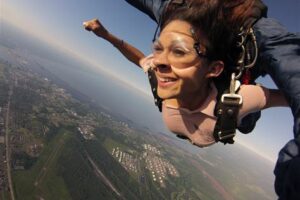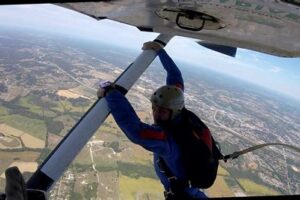Table of Contents
Skydiving Gear: Explore the essential equipment needed for a thrilling skydiving adventure. From harnesses and parachutes to altimeters and goggles, discover the must-have gear that ensures safety and enhances your adrenaline-fueled experience in the sky. Find out how to choose the right gear and get ready to take the leap of a lifetime!
Skydiving gear is an essential component for any thrill-seeker ready to take the plunge into the exhilarating world of freefall. Whether you are a seasoned skydiver or a beginner looking to experience the rush of soaring through the skies, having the right equipment is crucial for a safe and enjoyable jump. From state-of-the-art parachutes to high-tech altimeters, every piece of gear plays a vital role in ensuring a successful descent. In this article, we will delve into the world of skydiving gear and explore the must-have items that will make your skydiving experience unforgettable. So, grab your helmet and tighten those harnesses as we embark on an adventure through the world of skydiving equipment!
The Importance of High-Quality Skydiving Gear
Skydiving is an exhilarating and adrenaline-pumping adventure that allows thrill-seekers to experience the thrill of freefalling through the sky. However, it is crucial to prioritize safety when engaging in this extreme sport. One of the most critical aspects of skydiving safety is the gear used during the jump. High-quality skydiving gear not only ensures a safer experience but also provides comfort and ease of use for skydivers. Let’s explore the different components of skydiving gear and their significance.
Skydiving Suit: Protection and Aerodynamics
A skydiving suit, also known as a jumpsuit, is designed to protect skydivers from external factors such as windburn, cold temperatures, and potential abrasions during freefall. These suits are made from durable materials that can withstand high speeds and provide insulation. Additionally, skydiving suits are tailored to be tight-fitting to minimize air resistance and maximize aerodynamics, allowing skydivers to maintain stable body positions during the jump.
Parachute: The Lifesaver
The parachute is unquestionably the most vital piece of equipment in any skydiver’s arsenal. It is responsible for slowing down the descent after freefall and ensuring a safe landing. Parachutes are meticulously designed and rigorously tested to meet strict safety standards. Modern parachutes are equipped with various safety features, such as automatic activation devices (AAD), which can deploy the parachute automatically if the skydiver fails to do so at the predetermined altitude.
Altimeter: Guiding the Descent
An altimeter is a device used by skydivers to measure their altitude above ground level during a jump. It is essential for maintaining control and ensuring a safe landing. Altimeters provide real-time information about the skydiver’s altitude, allowing them to make necessary adjustments and deploy the parachute at the appropriate height. Advanced altimeters also offer additional features like audible alerts, which aid in maintaining precise altitude awareness.
Helmet: Protection for the Head
A helmet is an essential piece of skydiving gear that protects the skydiver’s head from potential impacts during the jump and landing. It minimizes the risk of head injuries and provides a secure mount for other devices such as cameras and audible altimeters. Helmets designed specifically for skydiving are lightweight, comfortable, and equipped with impact-absorbing materials to ensure maximum safety.
Goggles: Clear Vision in the Sky
Goggles are vital for protecting the skydiver’s eyes from wind, debris, and the intense rush of air during freefall. They provide clear vision, allowing skydivers to navigate safely during the descent. Skydiving goggles are designed to fit securely on the face and are often equipped with anti-fog coatings to prevent any hindrance to vision caused by condensation.
Jump Boots: Sturdy and Reliable
Jump boots, also known as skydiving boots, are specially designed footwear that provides ankle support and protection during the landing. These boots are made from durable materials to withstand impact and offer a firm grip on the ground. They help prevent ankle injuries and ensure stability during the landing phase of the jump.
Harness: Ensuring Safety and Comfort
A harness is an integral part of a skydiving gear setup. It connects the skydiver to the parachute system, ensuring a secure and controlled descent. Harnesses are adjustable to fit different body sizes and shapes, and they distribute the forces exerted during the opening and landing phases of the jump. Comfortable harnesses allow skydivers to have a more enjoyable experience while maintaining safety.
Reserve Parachute: The Backup Plan
A reserve parachute serves as a backup in case the main parachute fails to deploy correctly. It is an added layer of safety that every skydiver must have. Reserve parachutes are packed and maintained separately from the main parachute, ensuring that they are always in optimal condition. Skydivers go through extensive training to learn how to handle emergency situations and deploy the reserve parachute if necessary.
Additional Gear: Capturing the Thrill
While not essential for skydiving safety, many enthusiasts choose to document their jumps using cameras such as GoPro. These small, durable cameras can be mounted on helmets or other parts of the skydiving gear to capture the breathtaking views and adrenaline-filled moments. Recording the experience allows skydivers to relive their adventures and share them with others.
In conclusion, investing in high-quality skydiving gear is crucial for ensuring a safe and enjoyable experience. From the protective jumpsuit to the lifesaving parachute, each piece plays a vital role in maintaining safety during a skydive. Remember, safety should always be the top priority when engaging in this thrilling sport.
Introduction to Skydiving Gear
Skydiving gear plays a crucial role in ensuring the safety and success of each jump. From parachutes to altimeters, every piece of equipment must meet strict standards and be properly maintained. Understanding the various components of skydiving gear is essential for all enthusiasts.
Parachutes: The Lifeline in the Sky
The parachute is the most important piece of gear for any skydiver. It enables a safe descent by slowing down the freefall and ensuring a controlled landing. Modern parachutes are designed to provide stability and control, while also being lightweight and durable.
Harness and Container Systems: Ensuring Secure Connections
Harness and container systems are responsible for securely connecting the skydiver to the parachute. These systems distribute the weight evenly across the body and feature multiple attachment points for enhanced safety. They are designed to withstand high forces and provide reliable connections throughout the entire jump.
AAD (Automatic Activation Device): A Backup Safety Measure
The Automatic Activation Device, or AAD, is a critical piece of electronic equipment that serves as a backup safety measure. It is designed to automatically deploy the reserve parachute if it senses that the main parachute has not been deployed within a certain altitude range. This ensures that even if a skydiver fails to activate their parachute, they have a reliable backup to prevent a catastrophic fall.
Altimeters: Keeping Track of Altitude
Altimeters are essential instruments that allow skydivers to monitor their altitude during the jump. They provide real-time information about the current altitude, enabling skydivers to accurately time their parachute deployment. Altimeters come in various forms, including analog and digital, and are typically worn on the wrist or integrated into the helmet.
Jumpsuits: Enhancing Performance and Safety
Jumpsuits serve both practical and safety purposes in skydiving. They are designed to reduce drag during freefall, allowing skydivers to maintain stability and control. Additionally, jumpsuits provide an extra layer of protection against windburn, cold temperatures, and potential debris during descent.
Helmets: Protecting the Head
Helmets are crucial for protecting the head from potential impacts during skydiving. They are designed to provide both impact and penetration resistance. Additionally, helmets often feature built-in communication systems, allowing skydivers to communicate with each other and the ground crew effectively.
Additional Accessories: From Gloves to Goggles
Skydiving gear also includes various accessories to enhance comfort and safety. Gloves provide protection against cold temperatures and help maintain a secure grip on equipment. Goggles shield the eyes from wind, debris, and potential eye injuries. Other accessories may include audible altimeters, GPS trackers, and skydiving-specific shoes for added performance and safety.
Skydiving Gear: A Professional Perspective
When it comes to skydiving, the gear used is of utmost importance. The right equipment can make all the difference between a safe and thrilling experience and a potentially dangerous one. As a professional in the skydiving industry, I cannot stress enough the significance of using appropriate gear to ensure the safety and enjoyment of every jump.
Here are some key points to consider when it comes to skydiving gear:
- Parachute Systems:
- High-quality parachute systems are an absolute necessity for any skydiver.
- Modern parachutes are designed to provide maximum stability, control, and reliability.
- Regular maintenance and inspections of parachute systems are crucial to guarantee their proper functioning.
- Skydivers must choose a parachute system that suits their skill level and the type of jumps they intend to perform.
- Helmets:
- A well-fitting helmet is essential for protection against potential head injuries during skydiving.
- Modern helmets are designed to provide impact resistance and aerodynamic stability.
- It is imperative that skydivers select a helmet that meets safety standards and offers adequate protection.
- Helmets should be regularly inspected for any signs of damage or wear and replaced if necessary.
- Jumpsuits:
- Jumpsuits serve multiple purposes in skydiving, including providing aerodynamic stability and protecting the body from cold temperatures and windburn.
- Well-fitting jumpsuits allow for ease of movement without compromising safety.
- Skydivers should ensure that their jumpsuits are made from durable materials and have proper reinforcements in critical areas.
- Regular maintenance, including washing and patching, is necessary to prolong the life of jumpsuits.
- Altitude Devices:
- An accurate and reliable altitude device is crucial for skydivers to track their altitude during freefall.
- Modern altitude devices come in various forms, such as digital altimeters or audible altimeters that provide both visual and auditory cues.
- Skydivers must ensure that their altitude devices are calibrated correctly and regularly checked for accuracy.
- Having a backup altitude device is highly recommended to mitigate any potential malfunctions.
In conclusion, skydiving gear plays a pivotal role in ensuring the safety and success of every jump. Skydivers should invest in high-quality equipment, regularly maintain and inspect their gear, and choose products that are suitable for their skill level and jumping style. By prioritizing the use of appropriate gear, skydivers can embark on exhilarating adventures with peace of mind.
Thank you for taking the time to visit our blog and explore the exciting world of skydiving gear. We hope that this article has provided you with valuable insights into the essential equipment required for a safe and enjoyable skydiving experience. As professionals in the field, we understand the importance of using the right gear, and we are committed to helping you make informed choices.
In the first paragraph, we discussed the significance of a well-fitting jumpsuit, helmet, and goggles. These items not only protect you from the elements during the freefall but also contribute to your overall comfort and safety. We highlighted the importance of choosing a jumpsuit that fits snugly and allows for ease of movement. Additionally, we emphasized the need for a reliable helmet that provides adequate protection and a clear visor for unobstructed vision. Finally, we discussed the role of goggles in shielding your eyes from wind, debris, and potential damage.
The second paragraph focused on the crucial role of the parachute system in skydiving. We explained the components of a typical parachute system, including the main canopy, reserve canopy, and the harness. We stressed the importance of regular inspections and maintenance to ensure the integrity of the parachute system. Furthermore, we discussed the significance of choosing the right size and type of parachute based on factors such as weight, experience level, and intended use. By investing in a high-quality parachute system, you can enjoy peace of mind knowing that you have a reliable means of descent.
In the final paragraph, we addressed additional gear that may enhance your skydiving experience. We discussed the advantages of wearing altimeters to monitor altitude, as well as audible altimeters that provide audio cues during the jump. We also mentioned the benefits of wearing specialized gloves to protect your hands from cold temperatures and potential injuries. Lastly, we emphasized the importance of consulting with experienced skydivers and professionals to ensure that you select the most suitable gear for your specific needs and skill level.
As you embark on your skydiving journey, we encourage you to prioritize safety and invest in high-quality gear. Remember to conduct thorough research, seek expert advice, and choose equipment that fits well and meets industry standards. Skydiving is an exhilarating adventure, and having the right gear will enable you to fully enjoy the experience while ensuring your well-being. We wish you blue skies and safe landings!
Video Skydiving Gear
People Also Ask about Skydiving Gear:
-
What equipment do I need for skydiving?
- A parachute system: This includes the main parachute, reserve parachute, and the container that holds them.
- A jumpsuit: Designed to provide protection against wind resistance and to keep you comfortable during the jump.
- A helmet: Essential for head protection during freefall and landing.
- Goggles: Protect your eyes from wind, debris, and cold temperatures at high altitudes.
- An altimeter: A device used to measure altitude during the jump.
- A audible altimeter: An electronic device that provides audio signals indicating altitude.
-
Can I rent skydiving gear?
-
How much does skydiving gear cost?
-
How often should skydiving gear be inspected?
-
What certifications are required to pack a parachute?
Skydiving requires several pieces of specialized gear to ensure safety and a pleasant experience:
Yes, most skydiving centers offer gear rental options for individuals who are not ready to invest in their own equipment. However, renting gear is typically more expensive in the long run compared to purchasing your own gear if you plan to continue skydiving regularly.
The cost of skydiving gear can vary greatly depending on the brand, quality, and whether you choose new or used equipment. On average, a complete skydiving gear setup can cost anywhere between $3,000 and $10,000. It is important to remember that purchasing skydiving gear is an investment in your safety and enjoyment of the sport.
Skydiving gear should be inspected regularly to ensure its integrity and functionality. A common practice is to have a professional rigging loft perform a detailed inspection every 180 days or every six months. Additionally, the gear should be visually inspected before every jump to check for any signs of wear or damage.
To pack a parachute, you need to obtain the appropriate certification. In the United States, this typically involves completing a course and passing an exam administered by the United States Parachute Association (USPA). The specific certification is called a Senior Parachute Rigger rating.






